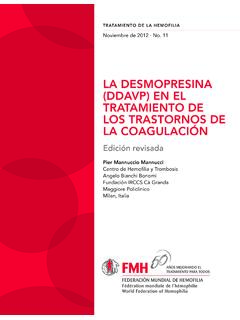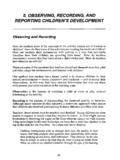Transcription of GROUP DYNAMICS AND TEAM BUILDING
1 HEMOPHILIA ORGANIZATION DEVELOPMENTMay 2009 No. 4 GROUP DYNAMICS AND TEAM BUILDINGS econd editionAnn-Marie NazzaroNational Hemophilia Foundation (USA)Joyce StrazzaboscoConsultant and Trainer (USA) Published by the World Federation of Hemophilia (WFH), 2003; revised 2009 World Federation of Hemophilia, 2009 The WFH encourages redistribution of its publications for educational purposes by not-for-profit hemophilia organizations. In order to obtain permission to reprint, redistribute, or translate this publication, please contact the Communications Department at the address below. This publication is accessible from the World Federation of Hemophilia s web site at , Additional copies are also available from the WFH at: World Federation of Hemophilia 1425 Ren L vesque Boulevard West, Suite 1010 Montr al, Qu bec H3G 1T7 CANADA Tel.
2 : (514) 875-7944 Fax : (514) 875-8916 E-mail: Internet: The Hemophilia Organization Development series aims to help hemophilia society leaders, staff, and volunteers develop the skills necessary to effectively represent the interests of people with hemophilia. The World Federation of Hemophilia does not engage in the practice of medicine and under no circumstances recommends particular treatment for specific individuals. Statements and opinions expressed here do not necessarily represent the opinions, policies, or recommendations of the World Federation of Hemophilia, its Executive Committee, or its staff. Table of Contents Introduction .. 1 Understanding GROUP DYNAMICS .. 1 Getting Acquainted .. 2 Clarifying Expectations.
3 3 GROUP Problem Solving .. 3 Team BUILDING .. 4 Team Development .. 6 Achieving GROUP Consensus .. 6 Conclusion .. 7 Resources .. 7 Appendix 1: Techniques for Managing GROUP DYNAMICS .. 8 Appendix 2: BUILDING and Managing Successful Virtual 12 Appendix 3: Broken Squares .. 13 Broken Squares Instruction Sheet for 14 Instructions to the Observer/Judge .. 14 Directions for Making the Squares for the Broken Square Exercise .. 15 Appendix 4: Team Stages .. 16 Appendix 5: Lost on the Moon .. 17 Actual NASA Ranking .. 18 GROUP DYNAMICS and Team BUILDING Ann-Marie Nazzaro, Joyce Strazzabosco Introduction This monograph was developed as a companion to a workshop on GROUP DYNAMICS and team BUILDING , presented at the WFH Global NMO Training Workshop May 16-18, 2002, in Huelva, Spain.
4 The workshop offered two methods of learning: (1) brief talks by the facilitators that described some theory, and (2) structured activities through which the participants experienced and then discussed some of the elements of GROUP DYNAMICS and team BUILDING . In this monograph, we will review some of the theories of GROUP DYNAMICS and team BUILDING that were addressed in that workshop. In addition, we have included structured activities that may be used in local GROUP settings. It would be advisable to identify a volunteer who has some experience in managing GROUP DYNAMICS to facilitate the activities. We wish to acknowledge that the content of this monograph is taken from materials and theories developed in the United States.
5 Therefore, it reflects a western European cultural context. Some human behaviours transcend cultural differences; others do not. The reader will be the best judge of how relevant the material may be for his or her local GROUP . We offer these ideas and exercises as tools to understanding and improving the effectiveness of one s own GROUP ; they are not intended to influence or replace readers cultural traditions. The subjects of GROUP DYNAMICS and team BUILDING are broad. One can study each of these topics for years and still have more to learn. There are many ways to approach each. A simple Internet search will result in thousands of web sites on either GROUP DYNAMICS or team BUILDING . These subjects are important because they influence how productive a GROUP or a team becomes.
6 By understanding GROUP DYNAMICS and by doing some team BUILDING , a GROUP can increase how much it accomplishes. Understanding GROUP DYNAMICS The term GROUP DYNAMICS refers to the interactions between people who are talking together in a GROUP setting. GROUP DYNAMICS can be studied in business settings, in volunteer settings, in classroom settings, and in social settings. Any time there are three or more individuals interacting or talking together, there are GROUP DYNAMICS . A great deal can be learned by observation. If one sits back quietly in a GROUP any GROUP one will begin to see certain behavioural patterns emerge. There will be at least one person who tends to take the lead in conversation, offering his or her thoughts and opinions freely.
7 There will be at least one person who remains quiet, sometimes not even appearing interested in the conversation. There may be someone who tends to interrupt other people, someone who wants the conversation to move along faster, or who wants to focus on a different subject. Another person may be concerned about peoples feelings and may try to make everyone feel equally welcome. These are only a few of the roles that people assume without even thinking about it when they are in a GROUP setting. GROUP roles are largely determined by a combination of a person s personality and his or her experience with GROUP settings. A person who is shy is more likely to sit back in a GROUP . A person who is impatient is more likely to push the discussion ahead.
8 A person who is very confident will offer more opinions. If such roles are more or less pre-determined, how can the GROUP DYNAMICS be improved? The way a GROUP interacts can be improved in several ways. There are training programs to attend and there are tests one can take to learn about one s communication style. Perhaps the simplest way to improve a GROUP s DYNAMICS is for one or more GROUP members to learn to manage the discussion, and thus help a GROUP accomplish its goals, much as a conductor 2 GROUP DYNAMICS and Team BUILDING manages the many players in an orchestra to produce a blended sound. By manage we mean respond to and redirect the behaviour or participation of an individual to a direction that is better for the GROUP .
9 Whether or not the GROUP is managed, GROUP roles will occur. By learning about the typical kinds of behaviour that emerge, and how to respond to them appropriately, one can improve the effectiveness of GROUP discussions. [See Appendix 1: Techniques for Managing GROUP DYNAMICS .] The two most common roles affecting a GROUP s effectiveness are the person who dominates and the person who remains silent. It can be as difficult to get the quiet person to speak as it is to get the talkative person to talk less. To manage the dominant person, one might say something like, You have a lot of good ideas, Carlos. I have written them down to discuss later. For now, we need to talk about _____. To the quieter person, one might say, What are your thoughts on this subject, Marie?
10 It is best to ask the quieter person a question that cannot be answered by a simple yes or no. A broad question casts a wider net, to use a fishing analogy. In any case, a direct and respectful approach is recommended where possible. (Note: In some cultures, directness is not appropriate. In some cultures, directness is acceptable, but only between certain types of people. This is an example of when a reader may have to translate a suggested behaviour into his or her own culture.) There are a variety of other roles that may emerge in a GROUP , and a textbook on GROUP DYNAMICS would be a good resource for learning more about them. In addition to being influenced by culture, roles are influenced by gender, age, race/ethnicity, religious tradition, and other traits.
















